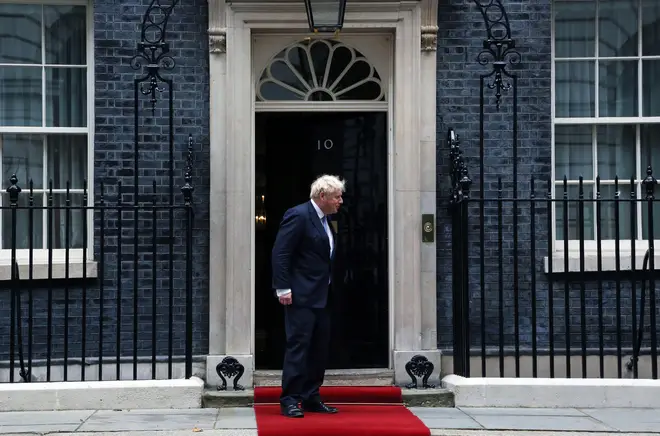
Ben Kentish 10pm - 1am
15 September 2021, 18:56 | Updated: 10 October 2022, 14:16

Boris Johnson’s long-awaited Cabinet reshuffle went further than many in Westminster expected, writes Ben Kentish.
While the sacking of Gavin Williamson as Education Secretary and demotion of Foreign Secretary Dominic Raab were widely predicted, other changes were not.
Read more: Cabinet reshuffle LIVE: Raab DEMOTED, Truss to FOREIGN SEC and Williamson SACKED
Among those unexpectedly booted out by the Prime Minister was arch loyalist Robert Jenrick, who started the day as Housing and Communities Secretary and ended it without any government job at all.
Robert Buckland, until today the Justice Secretary, was another not thought to be at risk. What was behind these surprise decisions?
Read more: 'THAT PRAT': Labour slams Williamson as Boris SACKS him from top team

Williamson 'more Sunday league than Premier league'
This reshuffle was partly about moving on from the Covid-19 pandemic and refocusing the government’s attention on the “levelling up” agenda that was so central to the Conservatives’ 2019 general election victory. Both Raab and Jenrick were relied on heavily by No10 during the height of the pandemic last year.
Read more: Dominic Raab's fall from grace: From acting PM to dramatic DEMOTION
Jenrick was often sent out to bat for the government in the media and at daily briefings, while Raab won praise from many quarters for the way he stepped in as acting PM when Johnson was taken ill. All of that counted for little as the Prime Minister reshaped his top team.
Read more: Gavin Williamson's biggest GAFFES as he is axed as education secretary
Johnson was clearly in the mood for looking forward, not back, and that brought a ruthless edge to the reshuffle. Before the sackings and promotions had even got underway, No10 were briefing that the government must “redouble our efforts to deliver on the people’s priorities” and said the PM “will be appointing ministers this afternoon with a focus on uniting and levelling up the whole country.”

Ben Kentish's analysis of Cabinet reshuffle
The ambition and scale of the wide-ranging “levelling up” agenda creates a big risk for the government that it will not be able to implement enough of it in time for the next election, especially given that the plan has been delayed for almost two years by Covid.
To have any chance of avoiding this pitfall, the Prime Minister needs the right ministers in key jobs – ministers who are not afraid to upset the apple cart and have the talent and determination to drive through sweeping, wholesale changes that actually improve people’s lives.
In that context, moving Michael Gove to the Department of Housing makes some sense. Gove was highly controversial as Education Secretary under David Cameron but showed he was willing to force through unpopular changes. That will be needed if he is to win the argument on issues like planning reform– something Jenrick struggled to do.
This reshuffle also furthered Boris Johnson’s reshaping of the Conservative Party and the Cabinet in his image. Remain-supporting, “One Nation” Conservatives like Buckland and Jenrick are out, while Liz Truss and Nadine Dorries – both very loyal to, liked by and in some ways similar to, Johnson – were handed big promotions (Foreign Secretary and Culture Secretary respectively).
Anne-Marie Trevelyan, a former Vote Leave board member, is also back in the Cabinet as International Trade Secretary. In part this was about freshening up the government’s top team and promoting new faces, which obviously means removing some of those with lower public profiles, like Jenrick and Buckland, in order to create space for others.
Many in Westminster believe that the next general election could be barely more than a year-and-a-half away, in spring 2023. It is very possible, then, that this new look Cabinet could be the one that leads the Conservatives into the next election.
The scale of the reshuffle, and the sacking of solid but unspectacular ministers, suggests the Prime Minister may already have at least half a mind on who will be the faces of the Tory party in that campaign.
The appointment of Oliver Dowden – seen as one of the more effective Cabinet ministers – as co-chair of the Conservative Party will do nothing to dispel that suggestion.
It is, at first glance, a demotion from his previous role as Culture Secretary but suggests that Johnson may be looking for a trusted ally to ramp up election planning and improve campaigning at Conservative Campaign Headquarters (CCHQ).
And yet despite all the moves, there are few faces that are genuinely new. With just four Cabinet ministers leaving government, this was more a case of rearranging the deckchairs than replacing the furniture.
That will frustrate those further down the ministerial ladder who have long been tipped for a bigger job and have been patiently (in most cases, at least) biding their time.
Some Tory MPs believe the Cabinet needs more new blood and want the Prime Minster to promote a new generation of ministers.
That has not happened. While this highly anticipated reshuffle was undoubtedly bold and certainly ruthless, there will be many on the Conservative benches unhappy that it did not go further still.